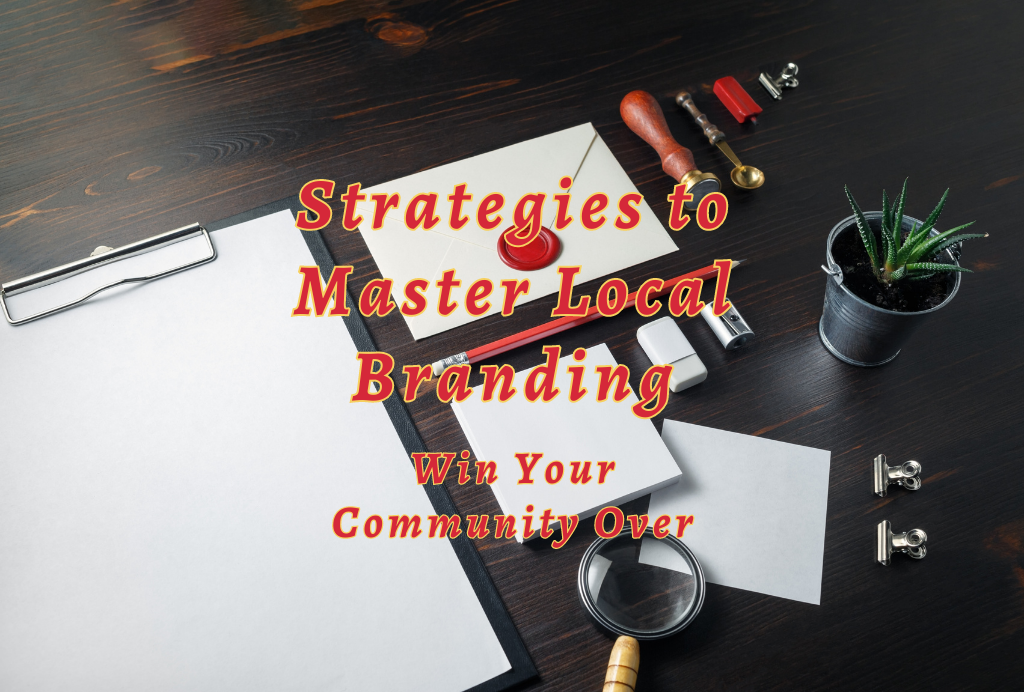7 Strategies to Master Local Branding: Win Your Community Over
Are you looking to make a big impact in your local community? With the right branding strategies, you can increase visibility and trust among customers. Strategies to brand your business are essential for any small business or entrepreneur hoping to stand out from the competition.
From understanding your local market and establishing an identity to investing in physical store branding and leveraging social media, these seven key tactics will help build strong relationships with potential customers near you. Take advantage of this unique opportunity today.

What is Local Branding, and Why Does it Matter?
Local branding is a marketing strategy focusing on connecting with local customers and building relationships within the community. It’s about creating an identity for your business that resonates with people in your area, which can help you stand out from competitors and attract more customers.
Why Local Branding Matters?
Local branding matters because it helps businesses to establish themselves as part of the local community. By engaging with locals through events, campaigns, and other initiatives, companies can create a positive image in their area and gain trust among potential customers. This can lead to increased sales and loyalty from existing customers who feel connected to the brand.
Approximately 89 percent of people use their smartphone to search for a local business at least once a week, with 58 percent searching daily.
What Makes Local Brands Unique?
The key difference between global and local brands is their customer engagement approach. Global brands typically focus on mass-market appeal, while local brands prioritize building relationships with individual customers through personalization and customization. Local businesses need to be more creative in connecting with their target audience.
Advantages of Local Brands Over Global Brands
A few advantages of local brands over global brands are listed below:
Local brands have a perfectly segmented customer base and operate within a relatively small region, allowing them to better understand the needs of their customers and provide tailored services that meet those needs.
For example, local restaurants may offer dishes that are specific to the area or cater to special dietary requirements. This allows them to stand out from global competitors, who often need more customization.
Unlike global brands, which focus on quantity rather than quality, local brands prioritize providing their customers with the best user experience possible. They strive to not only meet expectations but also exceed them by speaking the same language as their target audience and becoming part of the community they serve.
One major advantage that local businesses have over global ones is the ability to form personal connections with their customers through partnerships with neighborhood businesses or events in the area, like farmers markets or festivals where locals can come together and get involved in something bigger than themselves while supporting a business they care about at home too.
Another benefit of choosing a local brand over its larger counterparts is responsive service when things go wrong in the market or worldwide economic issues arise, such as recessions, etcetera; these companies are more likely able to respond quickly due to having fewer layers between management & operations staff so solutions can be implemented faster without waiting weeks months for approval from corporate headquarters like many large corporations require first before taking action (if ever).
Strategies to Master Local Branding
The following listed strategies will help you to master local branding.
Understand Your Local Market
Understanding your local market is essential for successful local branding. Knowing your target audience’s demographics, trends, and customer needs can help you create a strategy that resonates with them.
Start by researching the population in your area. Who are they? What age range do they fall into? Are there any distinct cultural or ethnic groups present? Knowing this information will help you tailor content to their interests and preferences.
Next, consider what type of products or services are popular in the area. Are there any particular items people tend to buy more often than others? This knowledge can inform decisions about pricing, promotions, and product selection.
It’s important to stay up-to-date on industry trends, so you know what’s currently popular among consumers in your region.
Your biggest marketing tool is also your customer base. Customers who feel like they are part of your brand are more likely to recommend it to their peers, which can significantly help your brand-building and marketing efforts.
For example, 88% of local customers rely on reviews to determine the quality of your company. You can create your band of influencers or brand evangelists if you can harness this power through online engagement, customer feedback, and reviews.
Researching other businesses in the same space as yours can provide valuable insights into consumer behavior and preferences in the area and potential areas where you could stand out from other companies offering similar products or services locally.
Establish Your Brand Identity
Creating a strong brand identity is essential for any business that wants to stand out from the competition and make an impact. Your brand identity should be unique, memorable, and reflect your company’s values. It will also help customers recognize you in a crowded marketplace.
Start by developing a logo that captures the essence of your business. Choose colors, fonts, and images representing your company’s personality and style. Make sure these elements are consistent across all platforms – from websites to social media channels – so customers can easily identify with you wherever they find you online or offline.
Next, create content that speaks directly to your target audience in their language while still reflecting the core values of your business. This could include blog posts about topics related to what you do or how-to guides on using products or services offered by your company. You can also use visuals such as infographics or videos to engage with potential customers more effectively than text alone would allow.
Invest in a Physical Store Brand Identity
Investing in physical store branding is important to establishing your business’s identity. It helps customers recognize and remember your brand and differentiate it from the competition. Here are some tips for creating a strong physical store brand identity:
A good sign can make all the difference in catching people’s attention. Make sure you choose a font and color scheme that reflects your brand and stands out from other businesses in the area.
Window displays are another great way to draw attention to your business. Try using props, mannequins, or artwork related to your product or service offerings—or use bright colors and interesting visuals to grab passersby’s attention.
Your interior design should reflect both the style of your brand and its values—for example, if you sell eco-friendly products, try incorporating sustainable materials into the design of your space (e.g., bamboo flooring). Additionally, be sure to include comfortable seating, so customers feel welcome when they enter the store.
Merchandising and visual merchandising are important elements of creating a strong physical store brand identity. Consider grouping items by theme or color palette, displaying them at different heights on shelves/tables/racks, and using signs with helpful information about each item, such as price tags. This can help customers perceive the merchandise more positively and make it easier for them to find what they need.
Implement Local SEO
Local SEO is an essential part of any business’s online marketing strategy. It helps to ensure that your website and content are visible in local search results, allowing you to reach potential customers looking for services or products in their area.
To get started with local SEO, there are a few key steps you should take:
The first step is to research the keywords people use when searching for businesses like yours in your local area. This will help you create content that targets those terms and optimize it accordingly. “Near me” or “close by” type searches grew by more than 900% over two years.
Once you have identified the relevant keywords, make sure they appear on your website – from titles and headings to meta descriptions and page copy – so that search engines can easily identify what your site is about and rank it accordingly in SERPs (search engine results pages).
Additionally, make sure all of your contact information (address, phone number) appears prominently on each page of your website, so users know where to find it quickly if needed.
Creating localized content around topics related to the services or products offered by your business can also boost visibility in local searches; this could include blog posts about events happening locally or industry news related specifically to the region where you operate etc.
Building citations across local directories such as Yelp., Yellow Pages, etc., along with link-building activities, will help increase authority signals, ultimately leading towards higher rankings within SERPs over time.
Attend Networking Events
Networking events are invaluable for businesses, influencers, entrepreneurs and startups. They offer the opportunity to build relationships with like-minded individuals in your industry, create strategic partnerships and potentially generate leads. Here’s how you can make the most of networking events:
Research ahead of time will help you determine which events are worth attending. Look at who is hosting or speaking at each event and what topics will be discussed to decide if it’s a good fit for your business goals.
You want to have a clear idea of what you want to get out of each event before attending so that you can prepare a concise pitch about yourself andor your business beforehand. This way, when someone asks, “What do you do?” or “What does your company specialize in?” you won’t be caught off guard by having nothing prepared.
It’s important to bring plenty of business cards with all relevant contact information (including social media handles).
Make sure that whatever outfit(s) you choose reflects positively on yourself, and your brand – dressing professionally shows respect for other attendees and gives off an air of professionalism.
Additionally, practice active listening skills during conversations; ask questions about their interests instead of just talking about yours.
Host workshops related to topics within your field or speak at local events. Not only does this give others insight into what makes up successful branding strategies, but it also helps establish credibility amongst peers. Plus, these activities provide excellent opportunities for lead generation.
Take Advantage of Local Advertising
Local advertising is an effective way to reach potential customers in your area. Radio, television, print media, and billboards are all great channels for getting the word out about your business.
When creating local advertising campaigns, it’s important to consider the following:
Leverage Social Media
Social media has become essential for businesses to promote their brand and reach potential customers. It is a great way to show off the different aspects of your business while also engaging with current customers. 71% of consumers who had a positive social media experience with a brand would recommend it to others.
Here are some tips on how you can leverage social media to help promote your brand:
Create Engaging Content
When creating content for social media platforms such as Facebook, Instagram, Twitter etc., it’s important to keep your target audience in mind. Consider using hashtags on relevant topics or trends that will help increase the visibility of your post among users who may not already follow you on social media platforms.
Hosting Contests or Giveaways
Another way businesses can leverage social media is by hosting contests or giveaways, which encourages user engagement while also helping spread awareness about your brand.
This could be done through polls where people vote for their favorite option or through creative challenges where people submit entries based on a certain theme related to your business/brand.
Engage With Your Followers
Social media isn’t just about pushing out promotional messages; it’s also about engaging with people who follow you. Responding to comments, answering questions, or simply liking posts from followers shows that you care about them and appreciate their support.
Stay Active & Consistent
Posting regularly on social media keeps people engaged with your brand as they know when new content will be released each week or month (depending on how often you post).
Additionally, staying active by posting relevant news stories related to your industry shows you are up-to-date on the latest trends, which could make potential customers more likely to trust what you offer over competitors who don’t stay as active online.
Use Paid Ads Strategically
While organic growth is important, paid ads can help give an extra boost if done correctly. When using paid ads strategically, focus on targeting users who fit within the demographic of those most likely interested in buying from you.
According to research, 75% of people say paid ads make it easier to find what they need.
Analyze Performance Data
Lastly, use analytics tools like Google Analytics or Facebook Insights to track performance data, such as website visits from links shared through social media platforms, so that you can see where traffic is coming from and adjust strategies accordingly if needed.
FAQs About Local Branding: Strategies to Brand Your Business
Conclusion
Local branding is a great way to build your business in the local market. Taking advantage of local advertising opportunities and getting involved in local events can help you reach more potential customers. Remember to leverage social media, as it’s a powerful tool for increasing brand awareness.
Following the above-listed strategies, you can successfully create a strong presence in the local market and grow your business.
Are you looking for creative and effective ways to elevate your brand? Brandbuddee is the perfect branding agency for businesses that need to stand out with style, relevance, and success. Our branding strategies are tailored specifically towards local businesses so that they can reach their target audience in an impactful way. Let us help you make a lasting impression on your customers! Contact us today to get started on crafting unique solutions that will leave a lasting mark.






